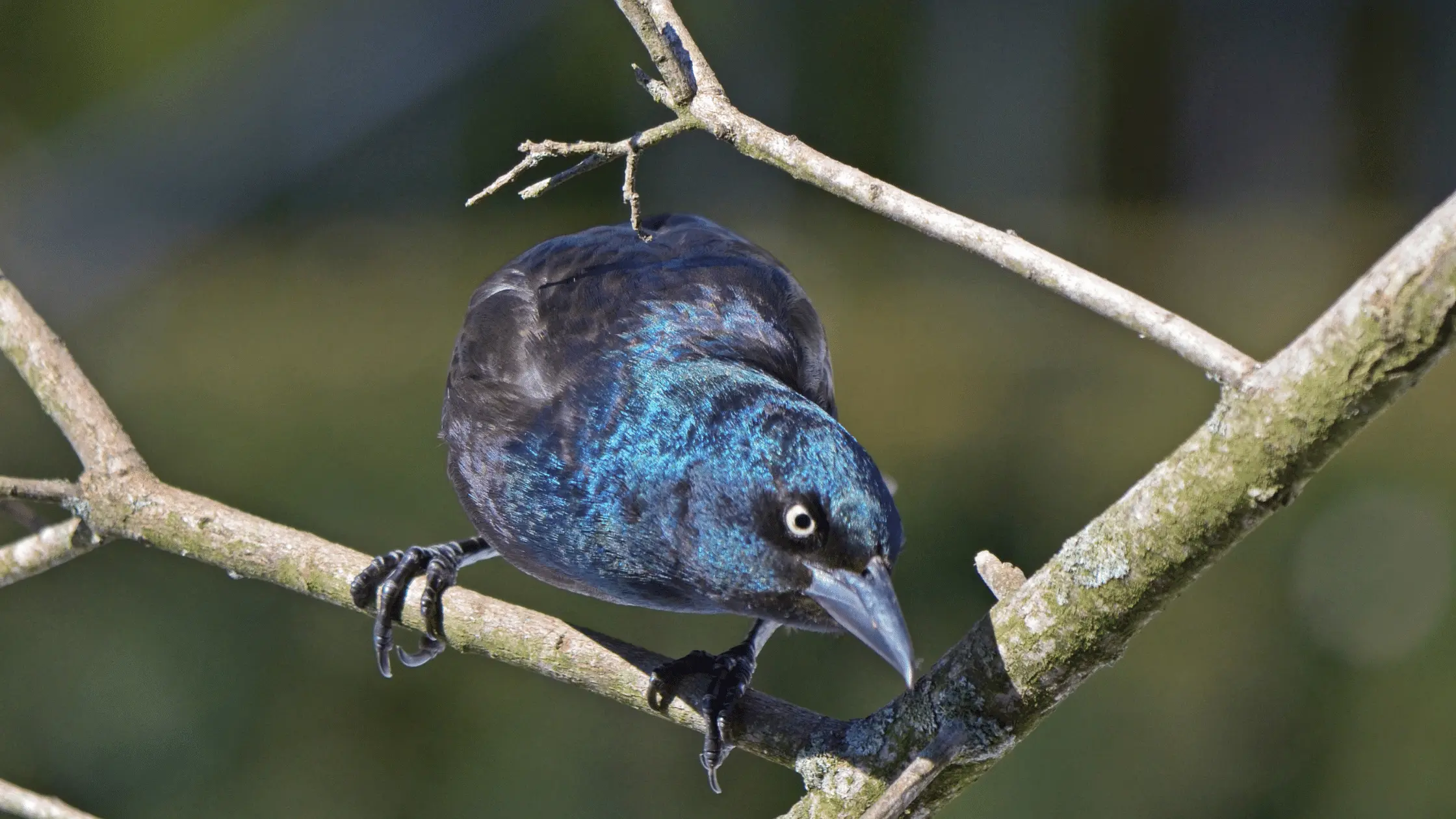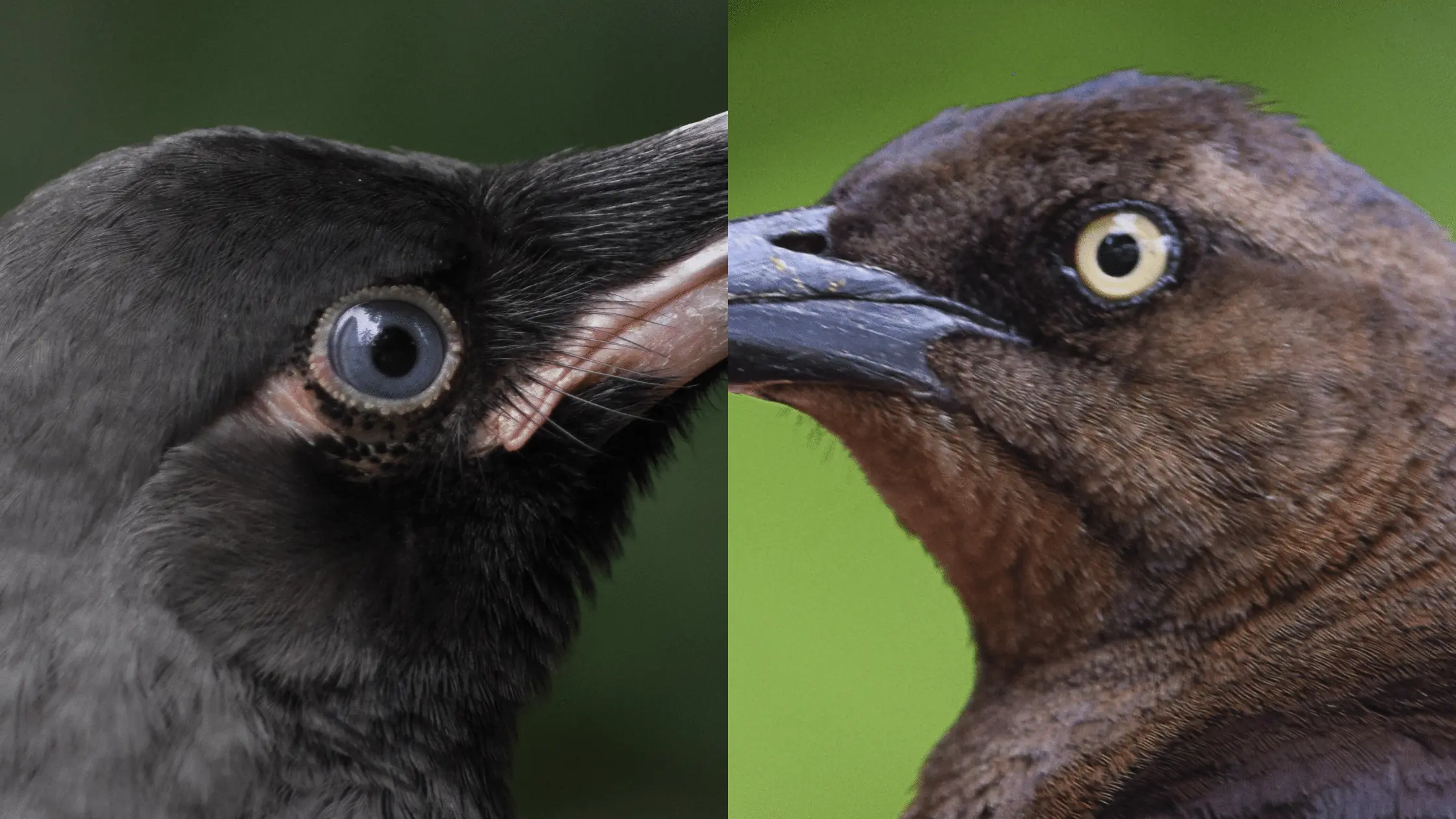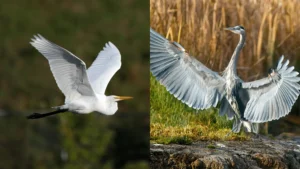I live in an urban area, so I often see black birds perch around close to my bird feeders. The blackbirds I spot usually have loud, piercing voices and tend to want to bully other birds that come to the feeders. I’ve often lumped these black birds together as crows until I realized there is a bird similar to a crow called the grackle.
Grackles and crows are so similar it’s haunting. They both have sharp beaks, and their plumage is black. It will be impossible to tell them apart without a closer look at these two birds. So, if these birds are so identical, are they different? Find out as you read.
What is a Grackle?

A grackle is a black bird taller than the average blackbird. They have a long and tapered bill with iridescent black bodies. They like to gather in trees and make a lot of noise. You will also see grackles walking around on lawns and fields. When they are in flight, their long tails will trail behind them. They also fold their long tails in a V-shape down the middle.
From a distance, a common grackle is black. However, upon closer look, you will notice that they have a purple head contrasting with an iridescent bronze body. The grackle has a bright golden eye that makes them seem as if they are always in deep thought. The female grackle isn’t as glossy as the male. I guess the males get all the bling.
Grackles like to gather in large flocks. They aren’t solitary birds like the downy woodpecker. Grackles forage for food in agricultural fields. You’d find them strutting on their impressive long legs as they peck for food. They don’t scratch like chickens. They rest on high places, such as telephone wires chattering away with the rest of their flock.
What is a Crow?

Crows are also blackbirds(at least by color standards) that are highly intelligent. I have written about the intellectual abilities of the American crow on this blog. Many of you know how the crow sounds thanks to series such as Game of Thrones, where we heard these black birds “cawing” loudly as the night king approached. Crows have a reputation for damaging crops and bullying other birds away from feeders.
The crow belongs to the Corvidae family. The Corvidae family also comprises other birds, such as jays, magpies, and nutcrackers. Compared to a raven, crows do not have thick bills, and they are typically smaller—a large crow measures about 20 inches, with wingspans reaching up to 39 inches.
Crows feed on the ground like grackles, walking intently as they look for a bite. Crows like to eat meat, and it isn’t beyond them to sometimes attack, kill and eat small weak birds. Farmers do everything possible to chase off crows because of their propensity to destroy crops. Crows are also sneaky thieves that like to steal food from other birds.
Grackle Vs. Crow: Battle Of The Blackbirds
Now that I have helped you understand the primary identification of a crow and a grackle, it is time to put them in a head-on collision. Even though a grackle and a crow seem similar, they have identifiable differences. First, they don’t even belong to the same family. Grackles belong to the Icteridae family, and the crow belongs to the Corvidae family. The following paragraph will go into more detail.
Grackle Vs. Crow: Size
Crows are bigger than grackles, most of the time. Crows have several species. The little crow measures around 35 to 45 cm long, and the American crow measures about 40 to 55 cm.
When compared to a crow, a grackle is small. On average, a grackle measures about 28 to 34cm. The wingspan of a grackle can be as long as 36 to 46 cm. The wingspan of an American crow is much longer, as long as 1m.
The American crow weighs around 300 to 600 grams, while the common grackle weighs about 74 to 142 grams. When it comes to size, the grackle has nothing on the crow.
Some grackles are pretty large, though—for example, the great-tailed grackle. However, even though the great-tailed grackle is big by “grackle standards,” it is smaller than most crow species. So, when it comes to size, it is the crow for the win.
Grackle Vs. Crow: Family Matters
This is one of the most significant differences between the grackle and the crow. Crows belong to the Corvidae family. The blue jay also belongs to the Corvidae family. Birds that belong to the Corvidae family are referred to as Corvids.
The American crow has over 120 species worldwide. They are probably the most well-known bird species in North America.
The grackle belongs to the blackbird family of Icteridae. What other birds belong to the Icteridae family? The Cowbirds, orioles, and meadowlarks all belong to the Icteridae and hundreds of different species.
Grackle Vs. Crow: Plumage
Crows are black or grey. They can also be a combination of both colors. On the other hand, grackles are black. However, a common grackle can have color variations upon closer inspection. The red-bellied grackle has a red stomach, and the boat-tailed grackle has some blue areas on its stomach.
Crows don’t have all the color variations that a grackle possesses. Jays are the only Corvids with color variations beyond black, white, and gray. The blue jay, which belongs to the Corvidae family, has blue plumage.
Grackle Vs. Crow: Eyes

They say that the eyes hold a lot of secrets. One of the secrets in telling a grackle apart from a crow is looking at their eyes. Crows are the dark knights of the Avian world. They are entirely black, which includes their eyes. The babies of crows do have blue eyes, though. However, as they grow into adults, their eyes go from blue to black.
The eyes of a grackle are pale gold or yellow. The grackle also has a very intent stare around its eyes. So, if you ever happen to stumble upon a black-colored bird and are having difficulty deciding if it’s a crow or a grackle, look at its eyes. If the eyes are yellow, it’s a grackle.
Grackle Vs. Crow: Calls and Vocalization
Of course, we all know the calls of crows. Who will forget their loud and annoying “caw”?
Don’t get me wrong; grackles aren’t any better. They also have a wide range of clicks and calls. However, if we were asked to choose between listening to a crow or a grackle, we would go for a grackle. This is because their calls are a bit more subtle than the vocalizations of crows.
Grackle Vs. Crow: Diet
When it comes to diet, the grackle and crow are pretty similar. They are both omnivores and feed on plants, insects, and invertebrates.
Both birds are not also beyond eating vertebrates such as rodents, small lizards, and even other birds. Both birds can be aggressive and regularly chase smaller birds away from feeders. Their aggressiveness is even more noticeable during their breeding season.
Both the crow and the grackle like to feed on the ground. They will walk around, looking for food. However, the crow shows more scavenging traits than a grackle.
Have you heard of “anting”? Anting is a strange feeding behavior practiced by grackles. Grackles will allow ants to climb their plumage and release formic acid on the grackle plumage, which helps them to preen their feathers. Other birds use anting techniques to feed on the ants.
Grackle Vs. Crow: Beak

The beak of a crow is very flexible. It allows them to eat a wide range of foods. They eat seeds, insects, fish, and other small animals. The beaks of crows are black, thick, and large.
Grackles also have a beak that is similar to that of a crow. However, the beak of a grackle is not as flexible as a crow’s.
Grackle Vs. Crow: Sexual Dimorphism
Both the males and females of a crow are very similar. They are so similar that it is difficult to tell them apart. The male crow is bigger than the female crow. However, you won’t be able to notice the size difference unless both the male and female are seated side by side.
On the other hand, the grackle is more noticeably sexually dimorphic. The male grackle weighs about 200 to 250 grams, and the females weigh even less than 100 to 120 grams. The female grackle color is not as bright as that of the males. The male grackle plumage is black with blue and purple iridescence. They also have a large, keeled tail, whereas the female grackle’s tail is short.
Grackle Vs. Crow: Habitat
There isn’t much difference in the grackle’s and crows’ habitats. Both crows and grackles can be found in agricultural fields and settlements. They will also make their habitats to be near a water source.
Grackles will peck for food in farmyards and new farms in rural locations. You will also see grackles following tractors as they feed on flying insects and worms exposed by the tractor. Grackles are also not beyond foraging in landfills and parks in the city. Don’t expect to see grackles in deep forests or places without any water access.
Crows are highly adaptable birds. They can adapt to almost any environment on earth. Crows can be seen in both rural and urban areas. Crows can and will inhabit them all, whether it is forests, grasslands, mountains, deserts, polar tundra, or rocky cliffs.
Grackle Vs. Crow: Reproduction and Mating
Regarding mating and reproduction, grackles and crows share some similarities and variances.
Grackles are monogamous, but it is just for one season. Even though grackles are monogamous for a season, some aren’t exactly committed to their monogamous relationships. So, don’t be surprised when you see some grackles being polygamous.
Grackles breed once a year. Their breeding takes place between March and July. Grackles are usually single-brooded. Occasionally, they can also be double-brooded.
The male grackles initiate the courtship. About one or three males will trail a female, folding their tails to look like a V. I guess the V-shaped tail must be pretty alluring to the female grackle. The number of males following the female keeps reducing until the last man stands.
When the male and female form a breeding pair, they fly off together, singing as they go. Ah, so cute!
As they form a breeding pair, the males will stay very close to the female grackle, literally following her anywhere she goes.
While I would have loved to think that the males follow the female grackle around because she so smites him, it isn’t so. The males follow the females around to ward off other males. The bodyguard’s duty stops when the female lays the egg.
On the other hand, crows are monogamous and cooperative in their breeding. When a pair mates, they will produce groups of up to 15 crows that stay together for a long time. Also, offspring from a previous breeding season will stick around to help raise the new hatchlings.
The mating season of crows comes around March and August. Between October and December, the mating season comes around for the second time.
Crows attract their mates by cooing, rattling, growling, and bowing. The mating ritual of crows takes place on the ground. The male will fluff up his feathers facing the female and bow as he repeatedly sings a short, rattling song. Of course, the females will swoon at such romantic gestures. Who wouldn’t?
When the female accepts the male as her mate, they perch together and preen each other’s feathers. Just like blue jays, crows mate for life.





